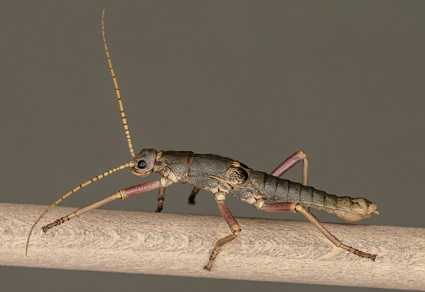References
- Bank, S. & Bradler, S. (2022) A second view on the evolution of flight in stick and leaf insects. BMC Ecology and Evolution, 22, 62. https://doi.org/10.1186/s12862-022-02018-5
- Bank, S., Buckley, T.R., Büscher, T.H., Bresseel, J., Constant, J., de Haan, M., Dittmar, D., Dräger, H., Kahar, R.S., Kang, A., Kneubühler, B., Langton-Myers, S.S. & Bradler, S. (2021) Reconstructing the nonadaptive radiation of an ancient lineage of ground-dwelling stick insects (Phasmatodea: Heteropterygidae). Systematic Entomology, 46 (3), 487–507. https://doi.org/10.1111/syen.12472
- Bradler, S. (2000) On the systematic position of Agathemera Stål 1875 within the Phasmatodea (Insecta). Zoology, 103 (Supplement III, DZG 93.1), 99.
- Bradler, S. (2003) Phasmatodea, Gespenstschrecken. In: Dathe, H.H. (Ed.), Lehrbuch der Speziellen Zoologie. Band I. Wirbellose Tiere. Teil 5. Insecta. Zweite Auflage. Spektrum Akademischer Verlag, Heidelberg, pp. 251–261.
- Bradler, S. (2009). Die Phylogenie der Stab- und Gespenstschrecken (Insecta: Phasmatodea). Species, Phylogeny and Evolution, 2, 3–139. https://doi.org/10.17875/gup2009-710
- Bradler, S. (2015) Der Phasmatodea Tree of Life: Überraschendes und Ungeklärtes in der Stabschrecken-Evolution. Entomologie Heute, 27, 1–23.
- Bradler, S. & Buckley, T.R. (2018) Biodiversity of Phasmatodea. In: Foottit, R.G. & Adler, P.H. (Eds.), Insect Biodiversity: Science and Society. Vol. II. Wiley-Blackwell, Hoboken, NJ, pp. 281–313.
- Brock, P.D. & Marshall, J. (2011) Order Phasmida Leach. 1815. Zootaxa, 3148 (1), 198. https://doi.org/10.11646/zootaxa.3148.1.36
- Büscher, T.H., Grohmann, C., Bradler, S. & Gorb, S. (2019) Tarsal attachment pads in Phasmatodea (Hexapoda: Insecta). Zoologica, 164, 1–94.
- Camousseight, A. (1995) Revision taxonomica del genero Agathemera (Phasmatodea: Pseudophasmatidae) en Chile. Revista Chilena de Entomología, 22, 35–53.
- Camousseight, A. (2005) Redefinición del género Agathemera Stål, 1875 (Phasmatodea, Pseudophasmatidae). Revista Chilena de Entomología, 31, 13–20.
- Cliquennois, N. (2020) Chapitre 18. Ordre des Phasmatodea (Phasmes). In: Duval, J.-P. (Ed.), Les Insectes du Monde (1). Biodiversité – Classification – Clés de détermination des familles. Museo Édtions, Plaissan, pp. 403–437.
- Conle, O.V. & Hennemann, F.H. (2002) Revision neotropischer Phasmatodea: Die Tribus Anisomorphini sensu Bradley & Galil 1977 (Insecta, Phasmatodea, Pseudophasmatidae). Spixiana Supplement, 28, 1–141.
- Cubillos, C., Cáceres, J.C., Villablanca, C., Villarreal, P., Baeza, M., Cabrera, R., Graether, S.P. & Veloso, C. (2018) Cold tolerance mechanisms of two arthropods from the Andean range of central Chile: Agathemera crassa (Insecta: Agathemeridae) and Euathlus condorito (Arachnida: Theraphosidae). Journal of Thermal Biology, 74, 133–139. https://doi.org/10.1016/j.jtherbio.2018.03.018
- Dominguez, M.C., San Blas, G., Agrain, F., Roig-Juñent, S.A., Scollo, A.M. & Debandi, G.O. (2009) Cladistic, biogeographic and environmental niche analysis of the species of Agathemera Stål (Phasmatida, Agathemeridae). Zootaxa, 2308 (1), 43–57. https://doi.org/10.11646/zootaxa.2308.1.3
- Forni, G., Martelossi, J., Valero, P., Hennemann, F.H., Conle, O., Luchetti, A. & Mantovani, B. (2022) Macroevolutionary analyses provide new evidence of phasmid wings evolution as a reversible process. Systematic Biology, 71 (6), 1471–1486. https://doi.org/10.1093/sysbio/syac038
- Friedemann, K., Wipfler, B., Bradler, S. & Beutel, R.G. (2012) On the head morphoogy of Phyllium and the phylogenetic relationships of Phasmatodea (Insecta). Acta Zoologica, 93 (2), 184–199. https://doi.org/10.1111/j.1463-6395.2010.00497.x
- Günther, K. (1953) Über die taxonomische Gliederung und geographische Verbreitung der Insektenordnung der Phasmatodea. Beiträge zur Entomologie, 3 (5), 541–563. https://doi.org/10.21248/contrib.entomol.3.5.541-563
- Klug, R. (2008) Anatomie des Pterothorax der Phasmatodea, Mantophasmatodea und Embioptera und seine Bedeutung für die Phylogenie der Polyneoptera. Species, Phylogeny and Evolution, 1, 171–217.
- Klug, R. & Bradler, S. (2006) The pregenital abdominal musculature in phasmids and its implications for the basal phylogeny of Phasmatodea (Insecta: Polyneoptera). Organisms, Diversity and Evolution, 6 (3), 171–184. https://doi.org/10.1016/j.ode.2005.08.004
- Redtenbacher, J. (1906). Die Insektenfamilie der Phasmiden I. Phasmidae Areolatae. Verlag von Wilhelm Engelmann, Leipzig, 180 pp., 6 pls.
- Robertson, J.A., Bradler, S. & Whiting, M.F. (2018) Evolution of oviposition techniques in stick and leaf insects (Phasmatodea). Frontiers in Ecology and Evolution, 6, 216. https://doi.org/10.3389/fevo.2018.00216
- Schmeda-Hirschmann, G. (2006) 4-Methyl-1-hepten-3-one, the defensive compound from Agathemera elegans (Philippi) (Phasmatidae) Insecta. Zeitschrift fur Naturforschung C, 61 (7–8), 592–594. https://doi.org/10.1515/znc-2006-7-820
- Schneider, C.O. (1934) Las emanaciones del chinchemayo Paradoxomorpha crassa. Revista Chilena de Historia Natural, 3, 44–46.
- Simon, S., Letsch, H., Blank, S., Buckley, T.R., Donath, A., Liu, S., Machida, R., Meusemann, K., Misof, B., Podsiadlowski, L., Zhou X., Wipfler, B. & Bradler, S. (2019) Old World and New World Phasmatodea: phylogenomics resolve the evolutionary history of stick and leaf insects. Frontiers in Ecology and Evolution, 7, 345. https://doi.org/10.3389/fevo.2019.00345
- Song, N., Li, X.-H. & Na, R.-S. (2020) Mitochondrial genomes of stick insects (Phasmatodea) and phylogenetic considerations. PLoS ONE, 15 (10), e0240186. https://doi.org/10.1371/journal.pone.0240186
- Stål, C. (1875) Recensio Orthopterorum. Revue critique des Orthoptères décrits par Linné, De Geer et Thunberg. Vol. 3. Norstedt & Söner, Stockholm, 105 pp.
- Tihelka, E., Cai, C.-Y., Giacomelli, M., Pisani, D. & Donoghue, P.C.J. (2020) Integrated phylogenomic and fossil evidence of stick and leaf insects (Phasmatodea) reveal a Permian-Triassic co-origination with insectivores. Royal Society Open Science, 7(11), 201689. https://doi.org/10.1098/rsos.201689
- Tilgner, E.H. (2002) Systematics of Phasmida. Dissertation, University of Georgia, Athens, GA.
- Vera, A., Pastenes, L., Veloso, C. & Méndez, M.A. (2012) Phylogenetic relationships in the genus Agathemera (Insecta: Phasmatodea) inferred from the genes 16S, COI and H3. Zoological Journal of the Linnean Society, 165 (1), 63–72. https://doi.org/10.1111/j.1096-3642.2011.00802.x
- Yang, H.-R., Engel, M.S., Shih, C.-K., Song, F., Zhao, Y.-S., Ren, D. & Gao, T.-P. (2023) Independent wing reductions and losses among stick and leaf insects (Phasmatodea), supported by new Cretaceous fossils in amber. BMC Biology, 21, 210. https://doi.org/10.1186/s12915-023-01720-0
- Yuan, Y., Zhang, L.-H., Li, K., Hong, Y.-H., Storey, K.B., Zhang, J.-Y. & Yu, D. (2023) Nine mitochondrial genomes of Phasmatodea with two novel mitochondrial gene rearrangements and phylogeny. Insects, 14 (5), 485. https://doi.org/10.3390/insects14050485
- Zompro, O. (2004) Revision of the genera of Areolatae, including the status of Timema and Agathemera (Insecta: Phasmatodea). Abhandlungen des Naturwissenschaftlichen Vereins in Hamburg, 37, 1–327.


